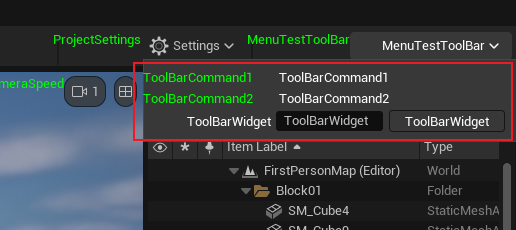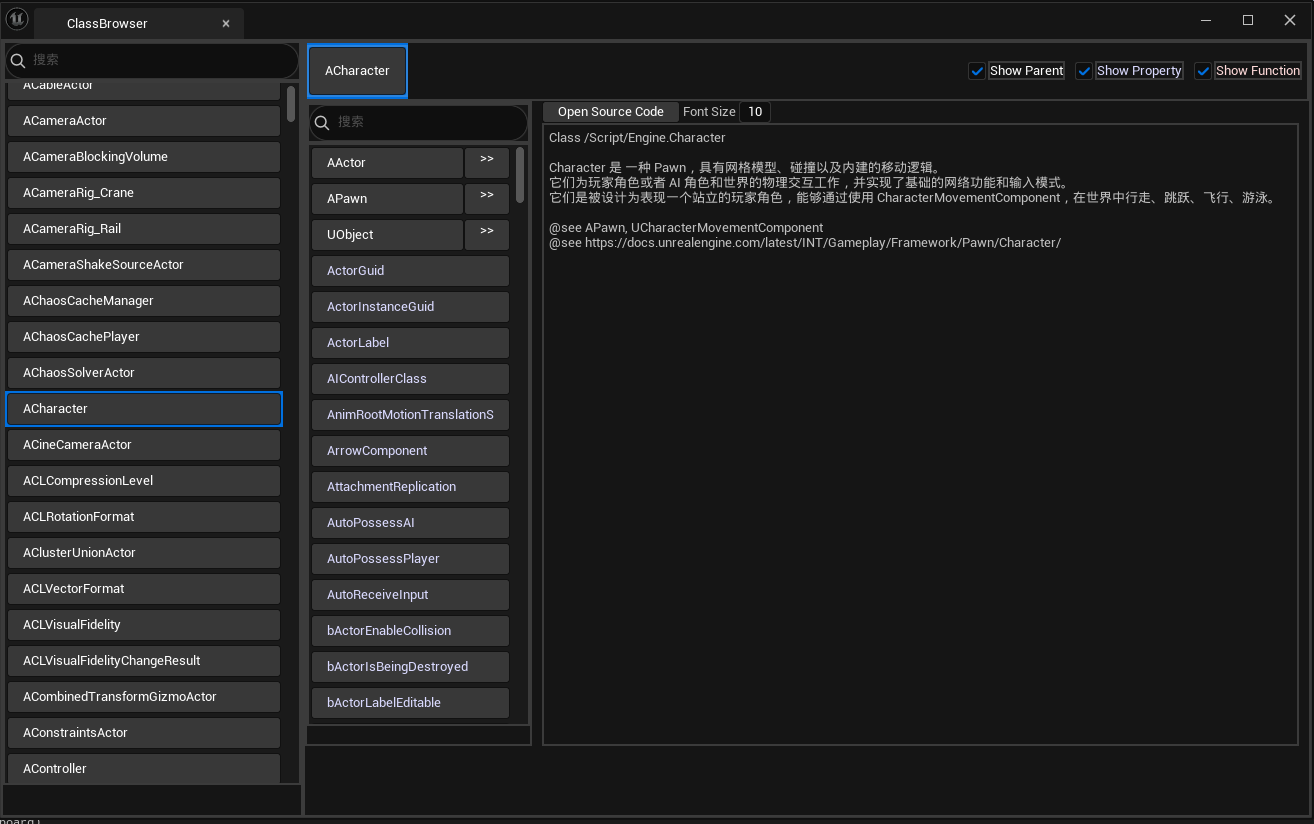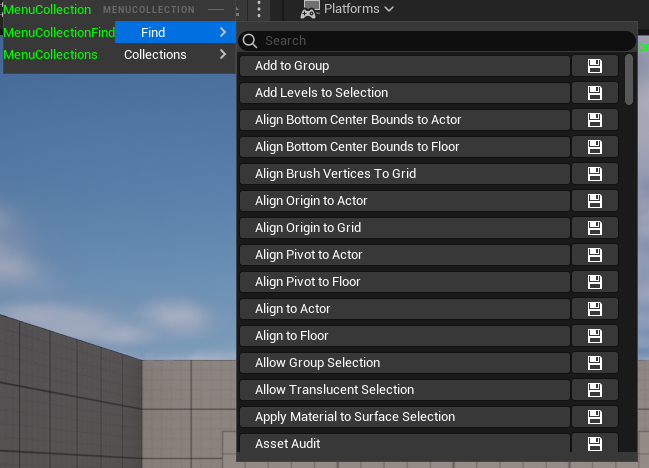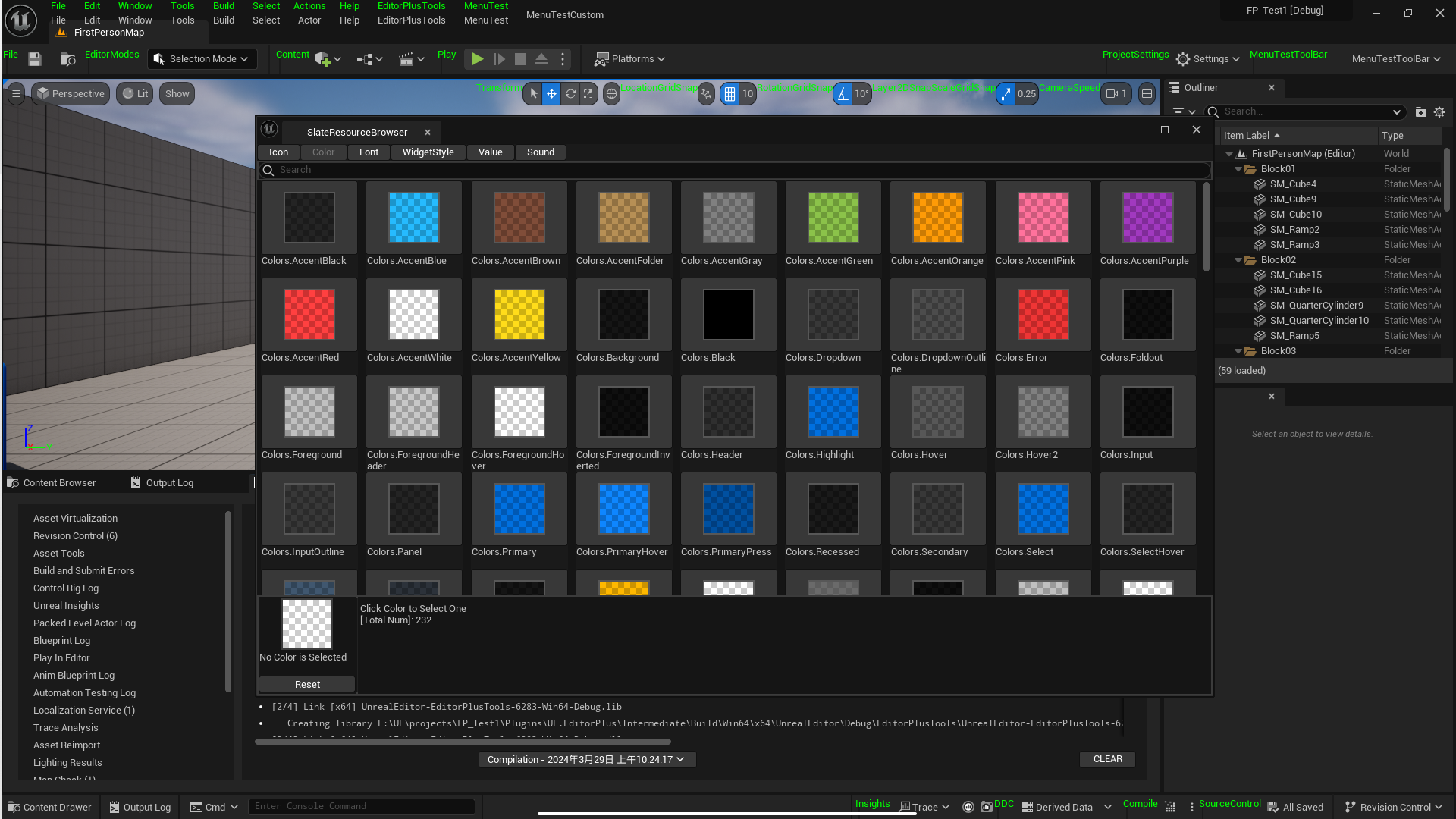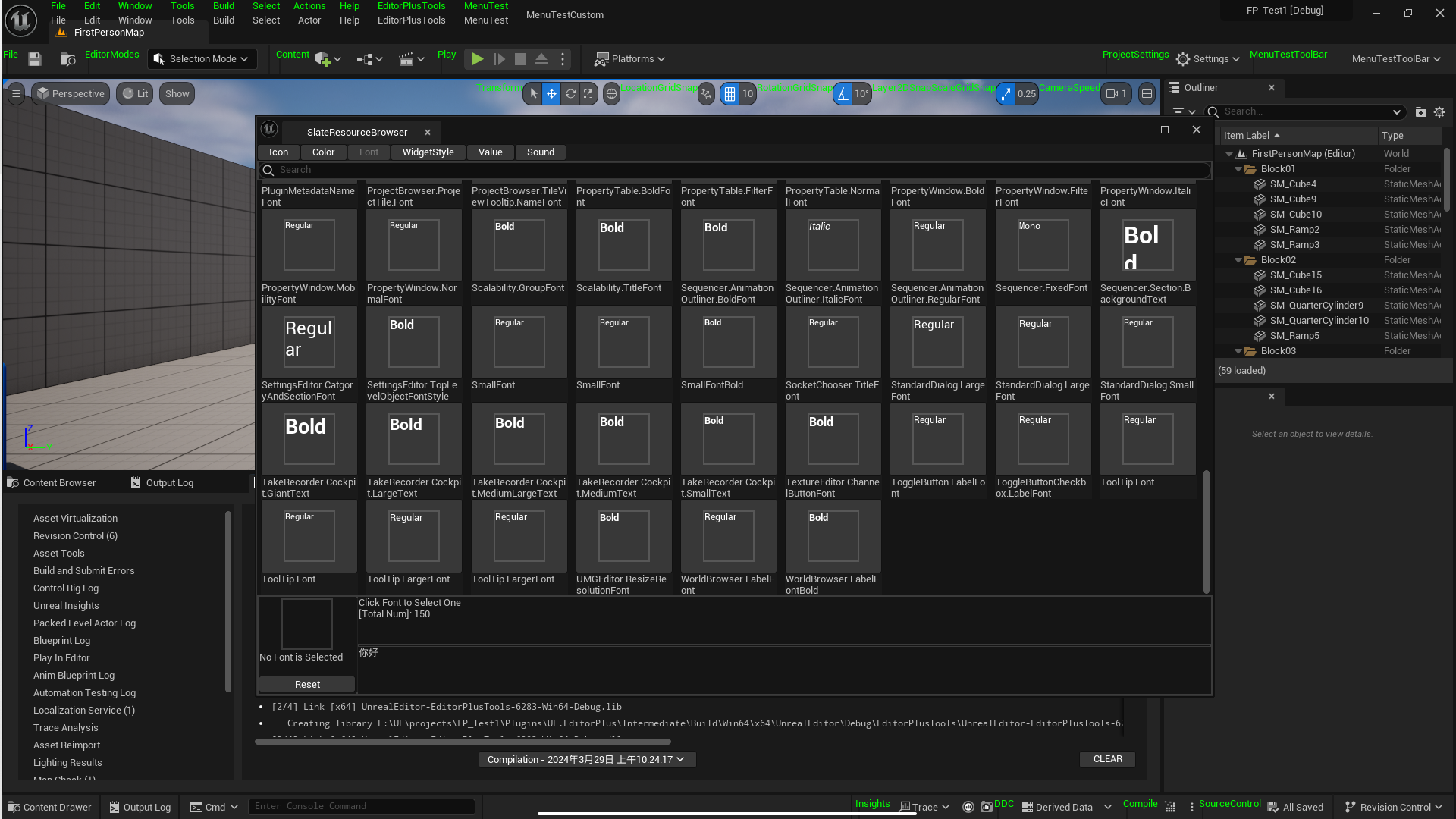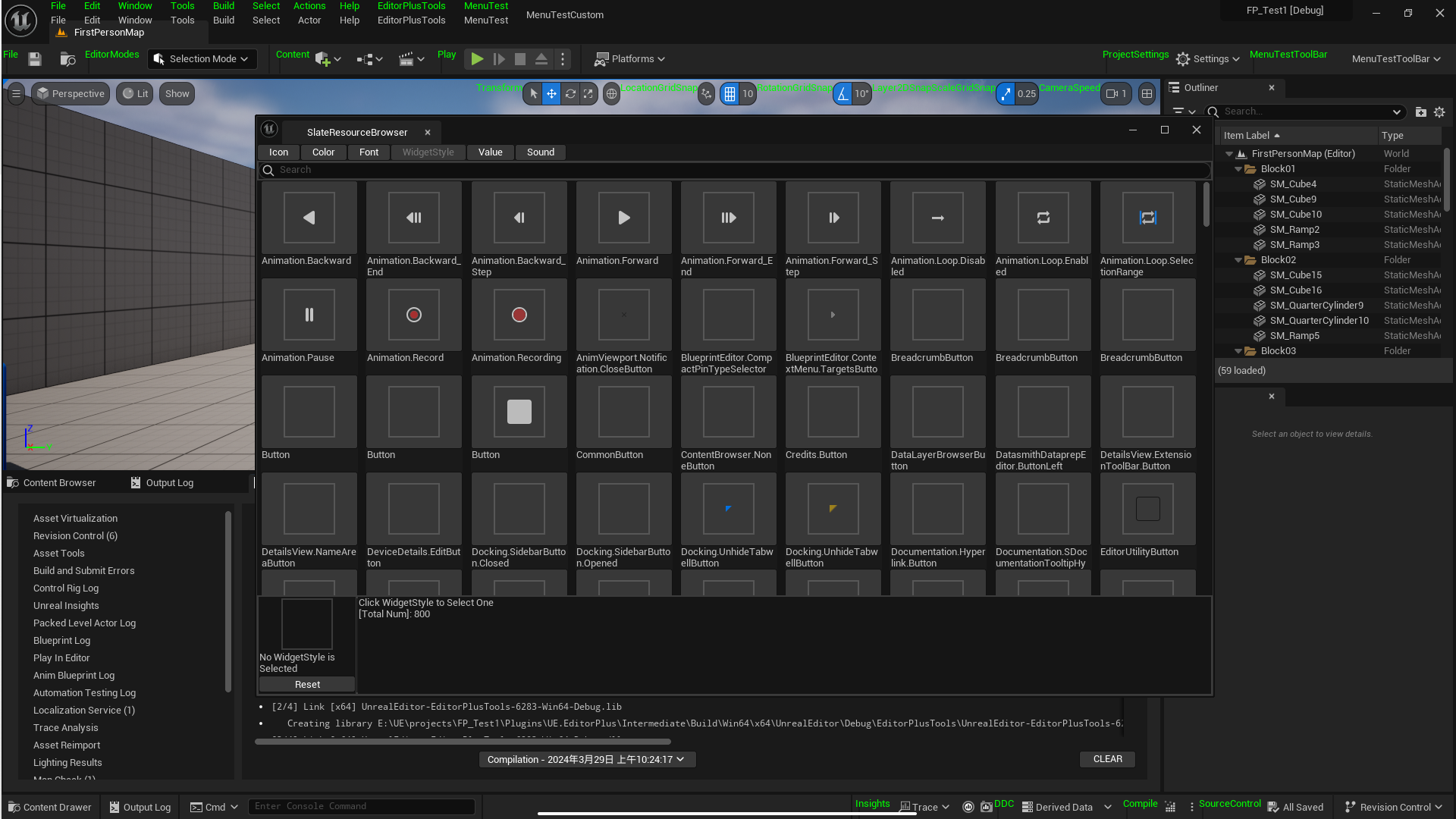UE 編輯器插件 UE.EditorPlus 說明文檔
介紹視頻
插件原始碼
商城下載
將此文本翻譯為繁體中文:
增加專案源代插件 EU.EditorPlus
參考文件:
- Chinese Traditional: 透過進行UE插件原始碼的添加來新增插件
- English: UE adds plugins through the plugin source code
插件說明
UE.EditorPlus 是一個 UE 編輯器插件,提供了一種方便的方式來擴展編輯器菜單,並支持高級方式來擴展,同時包含了一些實用的編輯器工具。本插件支持 UE5.3+。
擴展編輯器菜單
說明
支援多種方式擴展編輯器選單:
- 路徑方式:
RegisterPathAction("/<MenuBar>Bar/<SubMenu>SubMenu/<Command>Action") - 實例化方式:
EP_NEW_MENU(FEditorPlusMenuBar)("Bar") - 混合方式:
RegisterPath("/<MenuBar>Bar/<SubMenu>SubMenu/<Command>Action",EP_NEW_MENU(FEditorPlusCommand)("Action")
路徑方式
您可以透過以下方式註冊編輯器選單指令:
FEditorPlusPath::RegisterPathAction(
"/<MenuBar>Bar/<SubMenu>SubMenu/<Command>Action",
FExecuteAction::CreateLambda([]
{
// do action
})
);
這樣就可以在編輯器菜單欄 Help 後面增加一個菜單欄 Bar,Bar 裡面增加一個子菜單 SubMenu,SubMenu 裡面增加一個命令 Action。
完整的路徑格式將會是這樣的:/<Hook>HookName/<Type1>Name1/<Type2>Name2,第一個路徑必須是 <Hook>,目前支持的類型和限制:
<Hook>:表示需要在哪個 Hook 的位置上生成菜單,後續路徑不能有<Hook><MenuBar>:菜單列,後面路徑不能有<Hook>, <MenuBar>, <ToolBar><ToolBar>: 工具列,後面路徑不能有<Hook>、<MenuBar>、<ToolBar>。<Section>:菜單分節,後面路徑不能有<Hook>、<MenuBar>、<Section><Separator>:菜單分隔符,後面路徑不能有<Hook>、<MenuBar><SubMenu>:子選單,後面路徑不能有<Hook>, <MenuBar><Command>:菜單命令,後面不能有任何路徑<Widget>:更多可擴展定制的 Slate UI 組件,後面不能有任何路徑
更簡易的路徑形式:/BarName/SubMenuName1/SubMenuName2/CommandName,如果不指定類型,默认路徑的第一個是 <MenuBar>,中間的是 <SubMenu>,最後的是 <Command>。
如果沒有指定 <Hook>,則自動最前面加上 <Hook>Help,表示在 Help 菜單後面添加菜單欄。
實例化方式
路徑方式是自動把所有節點根據類型和默認參數實例化出來,我們也可以自己控制實例化,可以更細緻控制擴展的內容。
EP_NEW_MENU(FEditorPlusMenuBar)("MyBar", "MyBar", LOCTEXT("MyBar", "MyBar"), LOCTEXT("MyBarTips", "MyBarTips"))
->RegisterPath()
->Content({
EP_NEW_MENU(FEditorPlusSubMenu)("MySubMenu")
->Content({
EP_NEW_MENU(FEditorPlusCommand)("MyAction")
->BindAction(FExecuteAction::CreateLambda([]
{
// do action
})),
})
});
在實例化 MyBar 時,可以傳入 Hook 名稱、本地語系名稱和本地語系提示參數("MyBar", LOCTEXT("MyBar", "MyBar"), LOCTEXT("MyBarTips", "MyBarTips"))。上述程式碼等同於路徑方式 /<Hook>Help/<MenuBar>MyBar/<SubMenu>MySubMenu/<Command>MyAction。
混合方式
當然還可以兩種方式混合使用:
FEditorPlusPath::RegisterPath(
"/<MenuBar>Bar/<SubMenu>SubMenu/<Command>Action",
EP_NEW_MENU(FEditorPlusCommand)("Action")
->BindAction(FExecuteAction::CreateLambda([]
{
// do action
})),
);
在這種情況下,插件會自動實例化中間路徑的節點,最終的路徑使用用戶自己實例化的節點。
更多用例
標頭檔案:
路徑方式指定本地化語言,EP_FNAME_HOOK_AUTO 表示自動使用路徑名稱作為 Hook 名稱:
FEditorPlusPath::RegisterPathAction(
"/Bar/Action",
FExecuteAction::CreateLambda([]
{
// do action
}),
EP_FNAME_HOOK_AUTO,
LOCTEXT("Action", "Action"),
LOCTEXT("ActionTips", "ActionTips"));
通過路徑獲取節點並設置本地化文本:
FEditorPlusPath::GetNodeByPath("/MenuTest")
->SetFriendlyName(LOCTEXT("MenuTest", "MenuTest"))
->SetFriendlyTips(LOCTEXT("MenuTestTips", "MenuTestTips"));
在路径末端添加一個 Slate UI 控件
FEditorPlusPath::RegisterPath(
"/<MenuBar>Bar/<SubMenu>SubMenu/<Widget>Widget",
EP_NEW_MENU(FEditorPlusWidget)("Widget", LOCTEXT("Widget", "Widget"))
->BindWidget(SNew(SHorizontalBox)));
);
在 UE 內建的 Hook 裡面添加新的節點
多次聲明相同的路徑,都被識別成同一個路徑,因此可以不斷擴展相同的路徑。
FEditorPlusPath::RegisterPathAction("/MenuTest/SubMenu1/SubMenu1/Path1", Action, EP_FNAME_HOOK_AUTO, LOCTEXT("Path1", "Path1"), LOCTEXT("Path1Tips", "Path1Tips"));
FEditorPlusPath::RegisterPathAction("/MenuTest/SubMenu1/SubMenu1/Path2", Action, EP_FNAME_HOOK_AUTO, LOCTEXT("Path2", "Path2"), LOCTEXT("Path2Tips", "Path2Tips"));
為一個節點繼續擴展路徑
auto node = FEditorPlusPath::GetNodeByPath("/MenuTest");
FEditorPlusPath::RegisterChildPath(node, "<SubMenu>Sub/<Separator>Sep");
刪除一個路徑
擴展工具欄
FEditorPlusPath::RegisterPath("/<Hook>ProjectSettings/<ToolBar>MenuTestToolBar")
->Content({
EP_NEW_MENU(FEditorPlusCommand)("ToolBarCommand1")
->BindAction(...)
});
介面說明
class EDITORPLUS_API FEditorPlusPath
{
public:
static TSharedPtr<FEditorPlusMenuBase> RegisterPath(const FString& Path, const TSharedPtr<FEditorPlusMenuBase>& Menu=nullptr);
static TSharedPtr<FEditorPlusMenuBase> RegisterPath(const FString& Path, const FText& FriendlyName, const FText& FriendlyTips);
static TSharedPtr<FEditorPlusMenuBase> RegisterPathAction(
const FString& Path, const FExecuteAction& ExecuteAction, const FName& Hook=EP_FNAME_HOOK_AUTO,
const FText& FriendlyName=FText::GetEmpty(), const FText& FriendlyTips=FText::GetEmpty());
static TSharedPtr<FEditorPlusMenuBase> RegisterChildPath(
const TSharedRef<FEditorPlusMenuBase>& InParent, const FString& Path, const TSharedPtr<FEditorPlusMenuBase>& Menu=nullptr);
static TSharedPtr<FEditorPlusMenuBase> RegisterChildPath(
const TSharedRef<FEditorPlusMenuBase>& InParent, const FString& Path, const FText& FriendlyName, const FText& FriendlyTips);
static TSharedPtr<FEditorPlusMenuBase> RegisterChildPathAction(
const TSharedRef<FEditorPlusMenuBase>& InParent, const FString& Path, const FExecuteAction& ExecuteAction,
const FName& Hook=EP_FNAME_HOOK_AUTO, const FText& FriendlyName=FText::GetEmpty(), const FText& FriendlyTips=FText::GetEmpty());
static bool UnregisterPath(
const FString& Path, const TSharedPtr<FEditorPlusMenuBase>& Leaf=nullptr);
static TSharedPtr<FEditorPlusMenuBase> GetNodeByPath(const FString& Path);
};
RegisterPath:生成路径菜单
- RegisterPathAction:生成路徑菜單,並自動為末端 <Command> 節點綁定操作
- RegisterChildPath:為指定節點繼續生成子路徑
- RegisterChildPathAction:為指定節點繼續生成子路徑,並自動綁定操作
- UnregisterPath:刪除路徑,Leaf 在有多個同名的末端節點可以指定嚴格匹配。刪除的過程中,會回溯中間節點,一旦中間節點沒有任何子節點也會被刪除。
- GetNodeByPath:根據路徑獲取節點
節點類型
// base class of all node
class EDITORPLUS_API FEditorPlusMenuBase: public TSharedFromThis<FEditorPlusMenuBase> {}
class EDITORPLUS_API FEditorPlusHook: public TEditorPlusMenuBaseRoot {}
class EDITORPLUS_API FEditorPlusMenuBar: public TEditorPlusMenuBaseNode {}
class EDITORPLUS_API FEditorPlusToolBar: public TEditorPlusMenuBaseNode {}
class EDITORPLUS_API FEditorPlusSection: public TEditorPlusMenuBaseNode {}
class EDITORPLUS_API FEditorPlusSeparator: public TEditorPlusMenuBaseNode{}
class EDITORPLUS_API FEditorPlusSubMenu: public TEditorPlusMenuBaseNode {}
class EDITORPLUS_API FEditorPlusCommand: public TEditorPlusMenuBaseLeaf {}
class EDITORPLUS_API FEditorPlusWidget: public TEditorPlusMenuBaseLeaf {}
請參閱源碼以獲取更多範例和界面說明 UE.EditorPlus,測試用例 MenuTest.cpp
模組化管理
UE.EditorPlus 還提供了一個模塊化管理擴展功能表的框架,支持插件載入和卸載時,自動載入和卸載擴展的功能表
讓選單類別繼承 IEditorPlusToolInterface,並覆寫 OnStartup 和 OnShutdown 函數。OnStartup 負責創建選單,OnShutdown 負責調用節點的 Destroy 函數清理選單。單節點的引用數歸0時,則會執行自動清理。
class FMenuTest: public IEditorPlusToolInterface
{
public:
virtual void OnStartup() override;
virtual void OnShutdown() override;
}
void FMenuTest::OnStartup()
{
BuildPathMenu();
BuildCustomMenu();
BuildMixMenu();
BuildExtendMenu();
}
void FMenuTest::OnShutdown()
{
for(auto Menu: Menus)
{
if(Menu.IsValid()) Menu->Destroy();
}
Menus.Empty();
}
菜單管理類應繼承 IEditorPlusToolManagerInterface,並覆寫 AddTools 函數,在 AddTools 內添加菜單類。
class FEditorPlusToolsImpl: public IEditorPlusToolManagerInterface
{
public:
virtual void AddTools() override;
}
void FEditorPlusToolsImpl::AddTools()
{
if (!Tools.Num())
{
Tools.Emplace(MakeShared<FMenuTest>());
}
}
在插件加載和卸載時分別調用管理類的 StartupTools 和 ShutdownTools 函數。
void FEditorPlusToolsModule::StartupModule()
{
Impl = FEditorPlusToolsImpl::Get();
Impl->StartupTools();
}
void FEditorPlusToolsModule::ShutdownModule()
{
Impl->ShutdownTools();
}
完成以上適配後,則可以在加載和卸載插件時,自動加載和卸載擴展的菜單。
編輯器工具
UE.EditorPlus 還提供了一些實用的編輯器工具
建立編輯器視窗
使用 EditorPlus,可以很簡單地創建一個新的編輯器視窗。
// register spawn tab
Tab = MakeShared<FEditorPlusTab>(LOCTEXT("ClassBrowser", "ClassBrowser"), LOCTEXT("ClassBrowserTip", "Open the ClassBrowser"));
Tab->Register<SClassBrowserTab>();
// register menu action to spawn tab
FEditorPlusPath::RegisterPathAction(
"/EditorPlusTools/ClassBrowser",
FExecuteAction::CreateSP(Tab.ToSharedRef(), &FEditorPlusTab::TryInvokeTab),
);
SClassBrowserTab 是一個自訂的 UI 控件
class SClassBrowserTab final : public SCompoundWidget
{
SLATE_BEGIN_ARGS(SClassBrowserTab)
{}
SLATE_END_ARGS()
// ...
}
ClassBrowser
ClassBrowser 是一個 UE Class 查看器,透過選單 EditorPlusTools -> ClassBrowser 來開啟。
基於 UE 的反映來實現,可以很方便查看 UE 各種類型的成員資訊,說明提示等,支持模糊搜索,並能跳轉打開父類的資訊。
MenuCollections
MenuCollections 是一個菜單命令快速查找和收藏工具,能夠幫助您快速找到需要執行的菜單命令,並可以收藏常用命令,提升效率。
SlateResourceBrowser
SlateResourceBrowser 是一個可以快速查看 Slate UI 資源的工具,能夠幫助你瀏覽和查找需要的編輯器資源,方便擴展編輯器。
Original: https://wiki.disenone.site/tc
This post is protected by CC BY-NC-SA 4.0 agreement, should be reproduced with attribution.
Visitors. Total Visits. Page Visits.
此帖子是使用 ChatGPT 翻譯的,請在反饋中指出任何遺漏之處。

